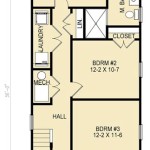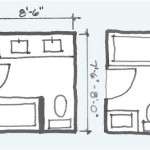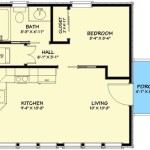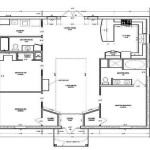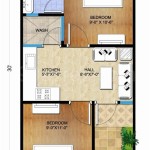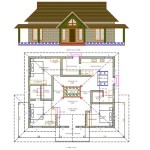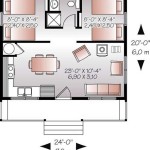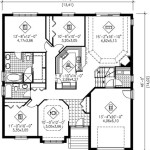One-Story 3-Bedroom House Plans: A Comprehensive Guide
The allure of the single-story, three-bedroom house plan remains consistently strong within the housing market. These designs offer a blend of practicality, accessibility, and often, affordability, making them a popular choice for a diverse range of homeowners, from young families to retirees. This article will explore the key considerations, benefits, and design variations associated with one-story, three-bedroom house plans.
Understanding the Appeal of Single-Story Living
One of the primary drivers behind the popularity of single-story homes lies in their enhanced accessibility. The absence of stairs eliminates a significant physical obstacle for individuals with mobility issues, including the elderly, those with disabilities, or families with young children. This feature contributes to a safer and more comfortable living environment for all occupants. Furthermore, the open floor plans often incorporated into single-story designs promote a sense of spaciousness and facilitate easier movement throughout the home. This ease of navigation can be particularly beneficial for those who value aging-in-place or simply prefer a more streamlined lifestyle.
Beyond accessibility, single-story homes often present advantages in terms of maintenance and construction. Exterior maintenance, such as gutter cleaning or roof repairs, is generally simplified due to the lower height of the structure. Similarly, interior upkeep, like painting walls or replacing flooring, can be less demanding without the complexities of stairways. From a construction perspective, single-story homes can be less complex and therefore potentially less expensive to build compared to multi-story dwellings. The foundations are often simpler, and the process of running utilities throughout the house can be more straightforward.
Finally, single-story homes can offer improved energy efficiency. With all living spaces on a single level, temperature regulation can be more consistent throughout the house. This eliminates the variations in temperature often experienced between upper and lower floors in multi-story homes, leading to reduced energy consumption for heating and cooling. Strategic placement of windows and proper insulation can further enhance the energy efficiency of a single-story design.
Key Considerations When Choosing a 3-Bedroom Single-Story Plan
Selecting the right three-bedroom, single-story house plan involves careful consideration of various factors, including lot size, lifestyle needs, and budget constraints. A thorough assessment of these elements is essential to ensure that the chosen plan aligns perfectly with the homeowner's requirements and preferences.
Lot size directly impacts the feasibility of different house plan options. A sprawling ranch-style home, for example, requires a significantly larger lot compared to a more compact, square-shaped design. Regulations concerning setbacks (the required distance between the house and property lines) must also be considered. Surveying the lot's topography is similarly crucial. A sloped lot may necessitate expensive grading or foundation work, potentially influencing the choice of house plan. Understanding these limitations upfront prevents costly surprises during the construction phase.
Lifestyle considerations play a pivotal role in determining the ideal floor plan. Families with young children may prioritize open living spaces for easy supervision, while those who frequently entertain guests might favor a larger kitchen and dining area. Individuals working from home will likely require a dedicated home office space. Assessing the number of occupants, their daily routines, and their preferences for privacy and socialization helps inform the layout and functionality of the house. The placement of bedrooms, bathrooms, and common areas should reflect the occupants' needs and promote a comfortable living environment.
Budgetary constraints are a fundamental factor that influences every aspect of the home-building process, including the choice of house plan. The size and complexity of the design, the materials used, and the level of customization all impact the overall cost. It's essential to establish a realistic budget before embarking on the house plan selection process. Obtaining preliminary cost estimates from builders or contractors based on different house plan options can provide valuable insights. Identifying areas where cost savings can be achieved, such as choosing more affordable finishes or simplifying the roof design, can help align the final design with the allocated budget.
Exploring Different 3-Bedroom Single-Story Design Styles
Three-bedroom single-story house plans are available in a wide range of architectural styles, each with its unique characteristics and aesthetic appeal. Understanding the nuances of these styles can help homeowners find a plan that resonates with their personal tastes and complements the surrounding environment.
Ranch-style homes, characterized by their low-pitched roofs, long horizontal layouts, and attached garages, offer a classic and comfortable living experience. These homes often feature large windows and sliding glass doors that connect the interior spaces to the outdoors. The open floor plans common in ranch-style designs promote a sense of spaciousness and facilitate easy flow between rooms. Ranch homes are particularly well-suited for larger lots, allowing for ample outdoor living space and landscaping possibilities.
Craftsman-style homes, distinguished by their prominent front porches, exposed rafters, and handcrafted details, exude a sense of warmth and charm. These homes often incorporate natural materials, such as wood and stone, and feature intricate trim work and built-in cabinetry. Craftsman designs emphasize quality craftsmanship and attention to detail, creating a timeless and inviting atmosphere. The layout typically involves a central living area flanked by bedrooms and bathrooms, providing a balance between privacy and shared spaces.
Modern or contemporary designs often feature clean lines, minimalist aesthetics, and a focus on functionality. These homes may incorporate large expanses of glass, flat roofs, and open floor plans to maximize natural light and create a seamless connection between indoor and outdoor spaces. Modern designs often prioritize energy efficiency and sustainable building practices, utilizing innovative materials and technologies to minimize environmental impact. The interior layouts are typically open and flexible, allowing for customization and adaptation to different lifestyle needs.
Beyond these core styles, numerous other variations exist, including cottage-style homes, farmhouse-style homes, and Mediterranean-style homes. Each style offers a unique blend of features and characteristics, allowing homeowners to express their individuality and create a home that reflects their personal preferences. Consulting with an architect or designer can help navigate the diverse range of options and find the perfect style to suit specific needs and tastes.
Furthermore, when selecting a plan, consider the orientation of the house on the lot. Optimizing the home's position to maximize sunlight exposure in the winter and minimize it in the summer can significantly reduce energy consumption. The placement of windows and overhangs should be carefully considered to control solar heat gain and glare. Landscape design can also play a crucial role in regulating temperature and enhancing the overall energy efficiency of the home.
In addition to the floor plan itself, attention should be paid to the exterior design elements. The roofline, siding materials, window styles, and landscaping all contribute to the overall aesthetic appeal of the home. Choosing materials that are durable, low-maintenance, and aesthetically pleasing can enhance the long-term value and curb appeal of the property. The exterior design should also complement the surrounding environment and architectural style of the neighborhood.
The interior design of the three-bedroom single-story home should reflect the homeowner's personal tastes and lifestyle. The selection of flooring, paint colors, lighting fixtures, and furniture should create a cohesive and inviting atmosphere. Maximizing storage space is crucial, particularly in smaller homes. Incorporating built-in shelving, closets, and organizational systems can help keep the home clutter-free and functional. The use of natural light and ventilation can enhance the overall comfort and well-being of the occupants. The layout should facilitate easy movement and interaction between family members while also providing ample space for privacy and relaxation. Finally, consider the potential for future modifications or additions to the home. Selecting a plan that allows for flexibility and adaptability can ensure that the home continues to meet the evolving needs of the homeowner over time. An unfinished basement or attic space can provide opportunities for future expansion, adding value and versatility to the property.

3 Bedroom House Plans With Open Floor Plan Remarkable One Story F Single Level Garage Y

Single Y 3 Bedroom House Plan Pinoy Eplans Bungalow Floor Plans One

One Story 3 Bedroom Farm House Style Plan 8823

3 Bedroom One Story Open Concept Home Plan Architectural Designs 790029glv House Plans

Contemporary Floor Plan Main 45 428 Modular Home Plans House One Story 1200 Sq Ft

One Story Mediterranean House Plan With 3 Ensuite Bedrooms 66389jmd Architectural Designs Plans

European Style House Plan 3 Beds 2 Baths 1452 Sq Ft 81 1416 Bedroom Floor Plans Garage

1 Story House Plans With 3 Master Suites And A Courtyard

200sqm Single Story 3 Bedroom House Plan With Garage Plandeluxe

One Level House Plans For A Contemporary 3 Bedroom Home

